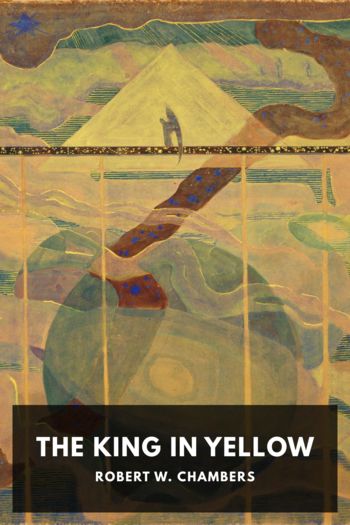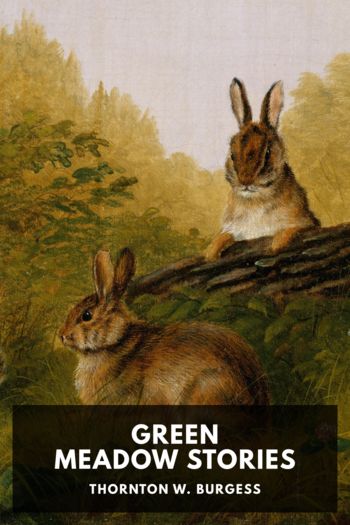The King in Yellow by Robert W. Chambers (best ereader for pdf and epub .txt) 📕

- Author: Robert W. Chambers
Book online «The King in Yellow by Robert W. Chambers (best ereader for pdf and epub .txt) 📕». Author Robert W. Chambers
And now, far away, over leagues of tossing cloud-waves, I saw the moon dripping with spray; and beyond, the towers of Carcosa rose behind the moon.
Death and the awful abode of lost souls, whither my weakness long ago had sent him, had changed him for every other eye but mine. And now I heard his voice, rising, swelling, thundering through the flaring light, and as I fell, the radiance increasing, increasing, poured over me in waves of flame. Then I sank into the depths, and I heard the King in Yellow whispering to my soul: “It is a fearful thing to fall into the hands of the living God!”
The Yellow Sign“Let the red dawn surmise
What we shall do,
When this blue starlight dies
And all is through.”
There are so many things which are impossible to explain! Why should certain chords in music make me think of the brown and golden tints of autumn foliage? Why should the Mass of Sainte Cécile bend my thoughts wandering among caverns whose walls blaze with ragged masses of virgin silver? What was it in the roar and turmoil of Broadway at six o’clock that flashed before my eyes the picture of a still Breton forest where sunlight filtered through spring foliage and Sylvia bent, half curiously, half tenderly, over a small green lizard, murmuring: “To think that this also is a little ward of God!”
When I first saw the watchman his back was toward me. I looked at him indifferently until he went into the church. I paid no more attention to him than I had to any other man who lounged through Washington Square that morning, and when I shut my window and turned back into my studio I had forgotten him. Late in the afternoon, the day being warm, I raised the window again and leaned out to get a sniff of air. A man was standing in the courtyard of the church, and I noticed him again with as little interest as I had that morning. I looked across the square to where the fountain was playing and then, with my mind filled with vague impressions of trees, asphalt drives, and the moving groups of nursemaids and holidaymakers, I started to walk back to my easel. As I turned, my listless glance included the man below in the churchyard. His face was toward me now, and with a perfectly involuntary movement I bent to see it. At the same moment he raised his head and looked at me. Instantly I thought of a coffin-worm. Whatever it was about the man that repelled me I did not know, but the impression of a plump white grave-worm was so intense and nauseating that I must have shown it in my expression, for he turned his puffy face away with a movement which made me think of a disturbed grub in a chestnut.
I went back to my easel and motioned the model to resume her pose. After working a while I was satisfied that I was spoiling what I had done as rapidly as possible, and I took up a palette knife and scraped the colour out again. The flesh tones were sallow and unhealthy, and I did not understand how I could have painted such sickly colour into a study which before that had glowed with healthy tones.
I looked at Tessie. She had not changed, and the clear flush of health dyed her neck and cheeks as I frowned.
“Is it something I’ve done?” she said.
“No—I’ve made a mess of this arm, and for the life of me I can’t see how I came to paint such mud as that into the canvas,” I replied.
“Don’t I pose well?” she insisted.
“Of course, perfectly.”
“Then it’s not my fault?”
“No. It’s my own.”
“I am very sorry,” she said.
I told her she could rest while I applied rag and turpentine to the plague spot on my canvas, and she went off to smoke a cigarette and look over the illustrations in the Courrier Français.
I did not know whether it was something in the turpentine or a defect in the canvas, but the more I scrubbed the more that gangrene seemed to spread. I worked like a beaver to get it out, and yet the disease appeared to creep from limb to limb of the study before me. Alarmed, I strove to arrest it, but now the colour on the breast changed and the whole figure seemed to absorb the infection as a sponge soaks up water. Vigorously I plied palette-knife, turpentine, and scraper, thinking all the time what a séance I should hold with Duval who had sold me the canvas; but soon I noticed that it was not the canvas which was defective nor yet the colours of Edward. “It must be the turpentine,” I thought angrily, “or else my eyes have become so blurred and confused by the afternoon light that I can’t see straight.” I called Tessie, the model. She came and leaned over my chair blowing rings of smoke into the air.
“What have you been doing to it?” she exclaimed.
“Nothing,” I growled, “it must be this turpentine!”
“What a horrible colour it is now,” she continued. “Do you think my flesh resembles green cheese?”
“No, I don’t,” I said angrily; “did you ever know me to paint like that before?”
“No, indeed!”
“Well, then!”
“It must be the turpentine, or something,” she admitted.
She slipped on a Japanese robe and walked to the window. I scraped and rubbed until I was tired, and finally picked up my brushes and hurled them through the canvas with a forcible expression, the tone alone of





Comments (0)